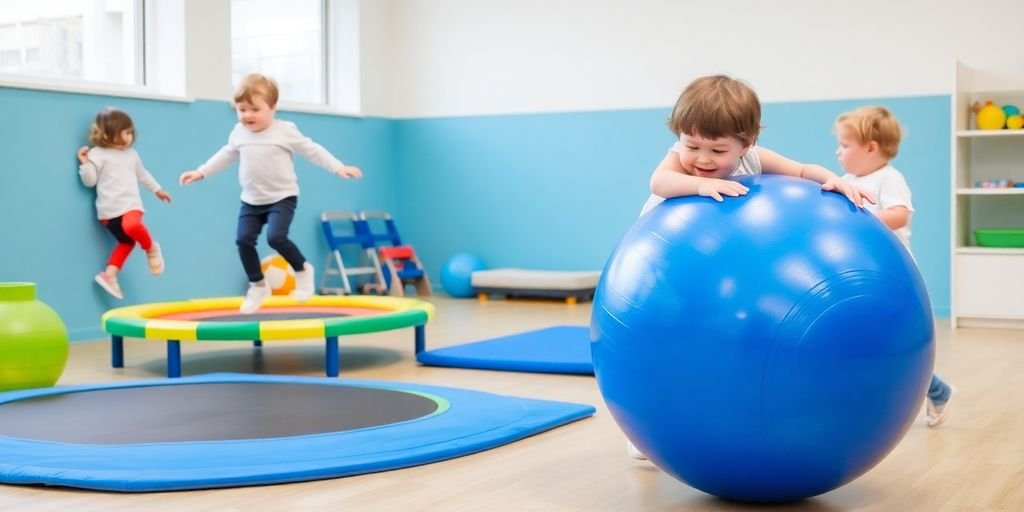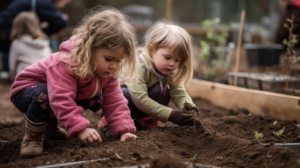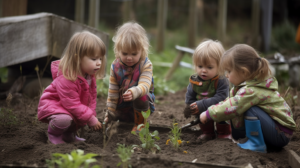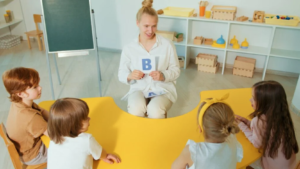When the weather takes a turn or you’re just stuck inside, keeping kids active can feel like a challenge. But fear not! There are plenty of fun ways to get them moving without stepping foot outside. Gross motor activities are perfect for burning off energy and helping kids develop their physical skills. Whether it’s hopping, running, or pretending to be animals, these activities are sure to keep your little ones entertained and active.
Key Takeaways
- Indoor activities can help kids stay active even when stuck inside.
- Gross motor activities are crucial for physical development.
- Simple games like hopscotch can be set up indoors easily.
- Relay races can be adapted for indoor play with minimal equipment.
- Animal walks are a fun way to engage kids’ imaginations while they exercise.
1. Hopscotch
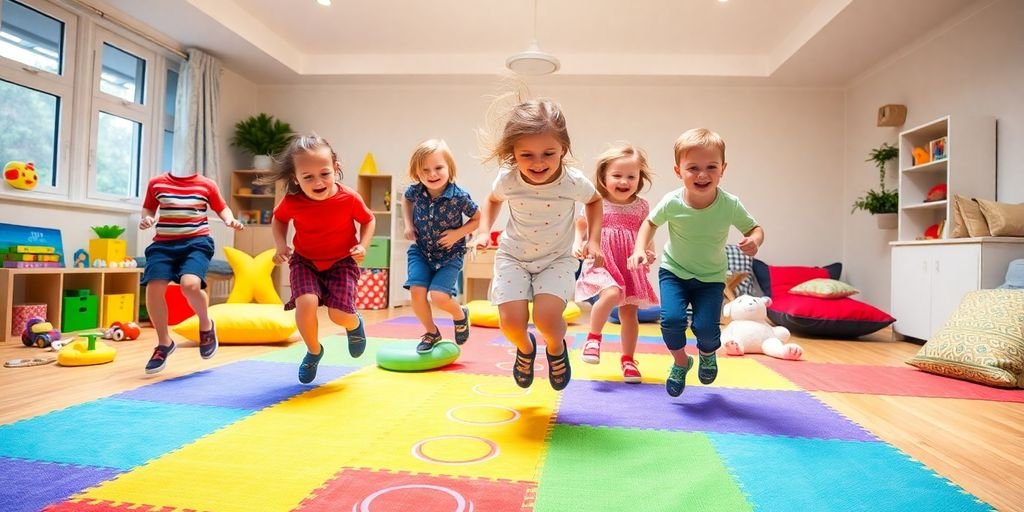
Hopscotch is a classic game that’s not just for the playground. It’s a fantastic indoor activity that helps kids burn off energy while developing coordination and balance. Creating an indoor hopscotch course can be as easy as using painter’s tape on the floor.
Setting Up Indoor Hopscotch
- Materials Needed: You’ll need painter’s tape, a small bean bag or any soft item to toss, and a bit of creativity.
- Design the Course: Use the tape to create a hopscotch grid on the floor. You can stick to the traditional numbered squares or mix it up with letters, shapes, or even sight words for a learning twist.
- Rules of the Game: Toss the bean bag onto a square, hop through the course on one foot, and skip the square with the bean bag. Retrieve the bean bag on your way back.
Variations to Try
- Alphabet Hopscotch: Instead of numbers, write letters in each square. Kids can call out the letter they land on or spell words as they go.
- Shape Hopscotch: Use different shapes instead of squares to add a new challenge.
- Math Hopscotch: Incorporate simple math problems in each square. Kids solve the problem before hopping.
Hopscotch is more than just a game; it’s a way to integrate fun and learning, keeping kids active and engaged. Plus, it’s adaptable for any age or skill level.
For more ideas on creating engaging hopping and jumping obstacle courses for children, consider the Ultra Dash Game, which offers a fun activity suitable for kids of all ages.
2. Relay Races

Relay races are a fantastic way to get kids moving and working together, even when you’re stuck indoors. All you need is a clear stretch of floor and a bit of imagination to create exciting challenges that will keep them entertained for hours.
Why Relay Races?
Relay races are not just about speed; they are about teamwork, coordination, and a little bit of strategy. Kids learn to work together, cheer each other on, and most importantly, have fun. Plus, they get to burn off some of that extra energy.
Setting Up Your Indoor Relay Race
- Choose Your Space: Make sure you have a long, clear area free of obstacles. This could be a hallway, a large room, or even a garage.
- Plan Your Races: Decide on the type of races you want to include. You could have traditional running relays or mix it up with scooter races, pillow-balancing challenges, or even crab walks.
- Gather Your Equipment: Depending on your chosen races, you might need items like scooters, pillows, or cones to mark start and finish lines.
- Divide into Teams: Split the kids into teams. This encourages cooperation and makes the races more exciting.
- Set the Rules: Explain the rules clearly. For example, if you’re doing a scooter race, make sure everyone knows they need to touch the finish line before heading back.
Fun Relay Race Ideas
- Scooter Relays: Use a scooter to race from one end of the room to the other. It’s a fun twist on the classic relay.
- Pillow Balancing: Balance a pillow on your head while racing. It’s harder than it sounds!
- Crab Walk Races: Kids walk like crabs, using their hands and feet, from start to finish.
- Animal Movement Races: Incorporate animal movements like hopping like a frog or waddling like a duck.
“Relay races, with their mix of competition and camaraderie, offer a perfect blend of physical activity and teamwork for kids on a rainy day.”
For more creative ideas, explore a collection of 73 uniquely entertaining relay games designed to enhance excitement and create lasting memories.
3. Obstacle Courses
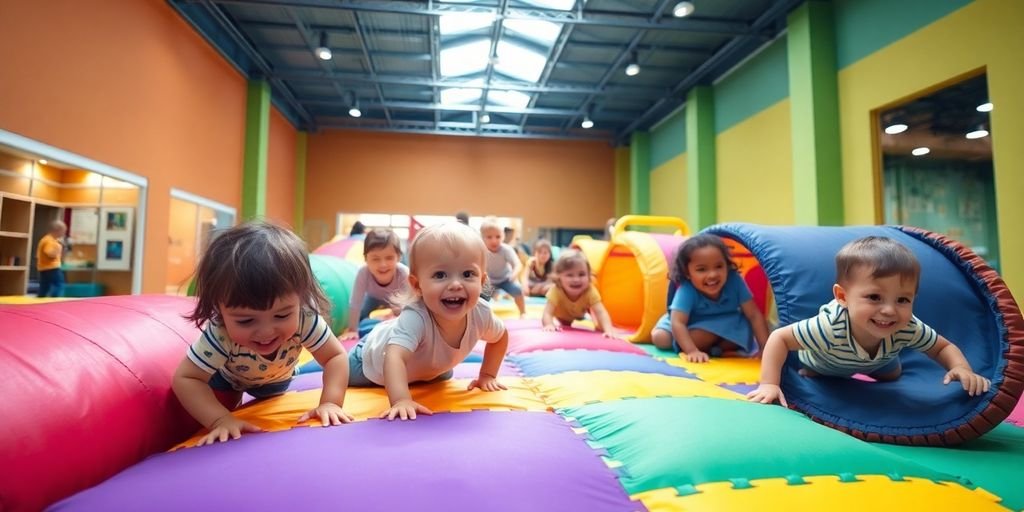
Setting up an indoor obstacle course can be a fantastic way to keep kids active on those dreary indoor days. Obstacle courses are perfect for burning energy while having tons of fun. You don’t need fancy equipment—just some creativity and a few household items.
Getting Started
First, clear a safe space in your living room or play area. Look around for items like cushions, chairs, and blankets. These can be transformed into obstacles for crawling, jumping, and balancing. Make sure to remove any sharp or breakable objects to avoid accidents.
Building the Course
- Crawl Under and Over: Use chairs and blankets to create tunnels. Kids can crawl under or climb over these makeshift barriers.
- Jumping Pads: Lay down some cushions or pillows for kids to jump from one to another. This helps improve their jumping skills and coordination.
- Balancing Act: A strip of tape on the floor can serve as a balance beam. Encourage kids to walk toe-to-heel along the line.
Adding Challenges
As kids master the basic course, you can increase the difficulty. Introduce timed runs to see who can complete the course the fastest or add new elements like hopping on one foot or carrying a small object through the course.
An indoor obstacle course not only keeps kids moving but also sparks their imagination. They can pretend they’re explorers navigating through a jungle or astronauts on a mission.
Safety Tips
- Always supervise young children to ensure they’re playing safely.
- Use soft materials for padding to prevent injuries.
- Adjust the course according to the age and skill level of the children involved.
Obstacle courses are a great way to engage kids physically and mentally. With a little imagination, your living room can become an exciting adventure land.
4. Animal Walks
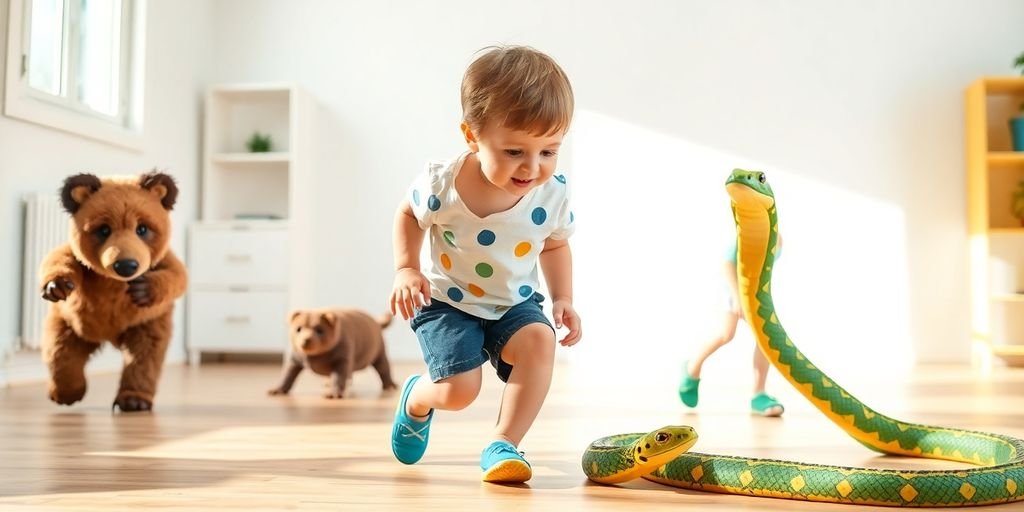
Exploring Animal Walks Indoors
When the weather keeps you inside, turning your living room into a mini jungle or zoo can be a fun way to get kids moving. Animal walks are perfect for this. They offer a creative way for children to engage their muscles and imaginations, all while having a blast.
Ideas to Get Started
- Crab Walk: Sit on the floor, lift your hips, and try to move sideways using your hands and feet. This is great for arm and core strength.
- Frog Jumps: Squat low to the ground and leap forward like a frog. This will get those leg muscles working.
- Bear Crawl: Get on all fours and move around, keeping your knees off the ground. It’s a full-body workout!
- Duck Waddle: Squat down and waddle like a duck. This challenges balance and leg strength.
Benefits of Animal Walks
Animal walks are not just fun; they are an excellent way to improve coordination and strength. They also help with balance and flexibility. Plus, they can be adapted for various ages and abilities, making them a versatile choice for indoor activity.
Make It a Game
Turn these movements into a game by giving points for the best animal impressions. You can also use Fun Animal Moves cards to inspire different movements and make it even more engaging.
Letting kids pretend to be their favorite animals encourages them to use their imagination and creativity, making exercise feel like play rather than a chore.
Final Thoughts
Animal walks are a fantastic way to keep kids active indoors. They’re easy to set up, require no special equipment, and can be tailored to suit the space and the children involved. Next time you’re stuck inside, give these a try and watch the fun unfold!
Conclusion
So, there you have it! Four fun and simple ways to keep the kids moving indoors. Whether it’s hopping around in a game of hopscotch or racing through a homemade obstacle course, these activities are sure to burn off some energy. Plus, they’re a great way to sneak in some exercise while having a blast. Next time the weather keeps you inside, remember these ideas. They’re not just good for the body, but also for the mind. Happy playing!
Frequently Asked Questions
What are gross motor skills?
Gross motor skills involve big movements using the arms, legs, feet, or entire body. They help with activities like running, jumping, and climbing.
Why are indoor gross motor activities important?
They help kids improve balance, coordination, and strength, even when they can’t play outside. These activities also support brain development and social skills.
Can you play sports indoors?
Yes, many sports can be adapted for indoor play, like mini basketball or indoor soccer, using safe equipment and spaces.
What is a simple indoor activity for kids?
Hopscotch is a fun and easy indoor activity. You can use tape to mark squares on the floor and have kids hop through them.
How do obstacle courses help kids?
Obstacle courses improve kids’ problem-solving skills, agility, and coordination as they navigate different challenges.
What are animal walks and why are they fun?
Animal walks are when kids move like different animals, such as crawling like a bear or hopping like a frog. They are fun and help build strength and coordination.


Ms. Kerri’s Corner provides a exciting virtual space for preschool learning. Through a variety of engaging activities, she exposes young minds to early math, literacy, science and social-emotional skills in a developmentally appropriate way. Centers for blocks, art, books and music allow children to explore hands-on learning at their own pace. Guided lessons subtly introduce number sense, letter sounds and narrative thinking. Careful observation gives insight into each child’s progress across domains. Viewers are also invited to participate, reinforcing that their ideas are valued. By making learning fun yet purposeful, Ms. Kerri lays the groundwork for future academic success while fostering creativity and imagination. Her program offers preschoolers valuable screen-based learning experiences.

